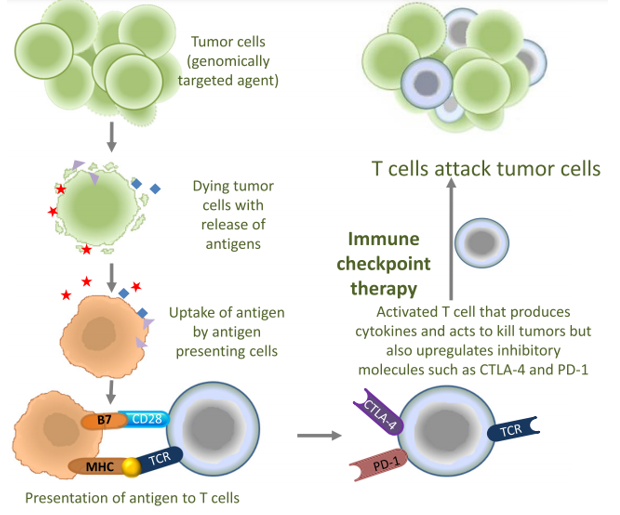Within the last few years, immune checkpoint blockade (ICB) has proven to be a groundbreaking advance in treating multiple types of advanced cancers. However, despite remarkable outcomes in some patients, a significant proportion of patients still do not attain a clinically meaningful response, reflecting the emergence of resistance. The description of resistance mechanisms to ICB allows for designing combination immunotherapy approaches to overcome these resistance mechanisms.
Other conventional cancer therapy, such as chemotherapy, radiotherapy, or phototherapy, have been shown to change the immune-suppressive tumor microenvironment and potentially synergize with ICB therapy. Therefore, combinations of ICB with chemotherapy, radiotherapy, and other immunotherapies such as phototherapy are being investigated.
 Fig.1. Combination therapy of immune checkpoint inhibitors with conventional therapy.1,2
Fig.1. Combination therapy of immune checkpoint inhibitors with conventional therapy.1,2
Apoptosis of cancer cells induced by chemotherapeutic drugs, also called immunogenic cell death, can release many damage-associated signals, which can be engulfed by antigen-presenting cells, triggering specific antitumor immune responses. Combining chemotherapy and ICB has a proven synergistic effect since chemotherapy aids in fast tumor regression and reduces tumor burden. At the same time, ICB may prolong this effect inducing a long-lasting anti-tumor response. Currently, three combinations have been approved for first-line treatment, all for advanced NSCLC.
Radiotherapy can convert immunologically ‘cold’ tumors into ‘hot’ tumors through distinct mechanisms. From the clinical standpoint, there has been increasing evidence that a combination of targeted radiotherapy and immunotherapy appears to be safe and may lead to improved tumor responses. With the increasing recognition of the ability of radiotherapy to prime and modulate tumor immune responses, the combination of radiotherapy with ICB could further expand the utility of immunotherapy across a broad range of malignancies and indications in the upcoming years.
Phototherapy is a noninvasive and novel therapeutic technique, including photothermal therapy (PTT) and photodynamic therapy (PDT). The original idea of phototherapy was for the destruction of the tumor. However, it is now realized that a more important phenomenon arising from phototherapy is immunogenic cell death (ICD), which releases damaged-associated molecular patterns (DAMPs), thereby increasing the immunogenicity of the tumor microenvironment. Due to these features, phototherapy has emerged as an excellent tool to complement ICB for a more efficacious cancer treatment regime. Therefore, the combination of phototherapy with ICB endows unique synergistic mechanisms to boost immune activation for cancer therapy and significantly improve cancer prognosis.
At Creative Biolabs, all services can be tailored to our client's specific needs. With long-term expertise in immune checkpoint drug development, we offer a series of custom services for immune checkpoints, including but not limited to:
Please do not hesitate to contact us for more detailed information.
References
All listed customized services & products are for research use only, not intended for pharmaceutical, diagnostic, therapeutic, or any in vivo human use.
USA
Tel:
Fax:
Email:
Copyright © 2025 Creative Biolabs. All Rights Reserved.